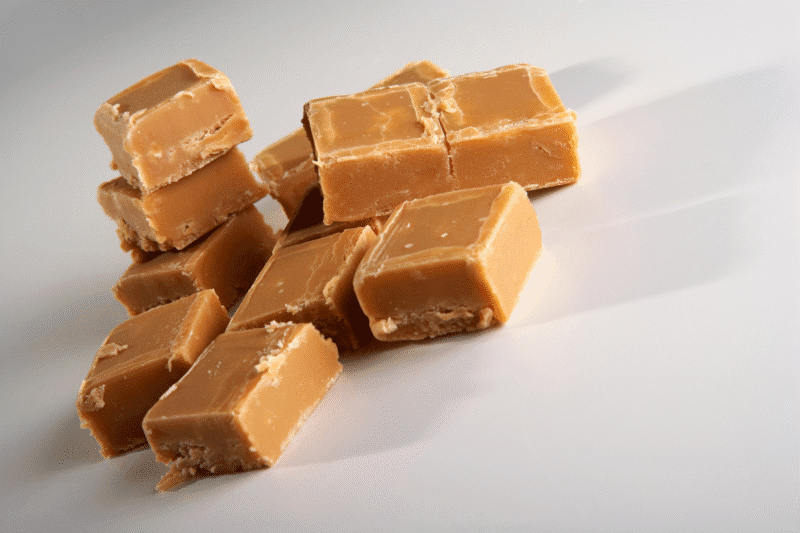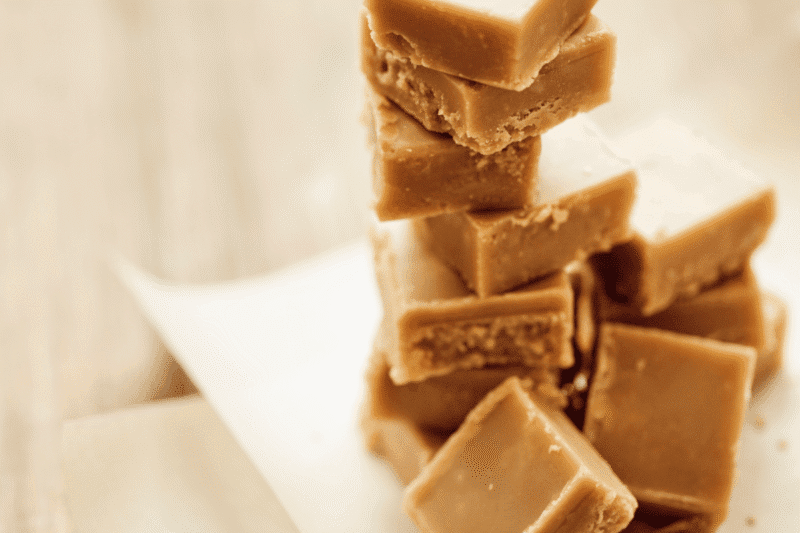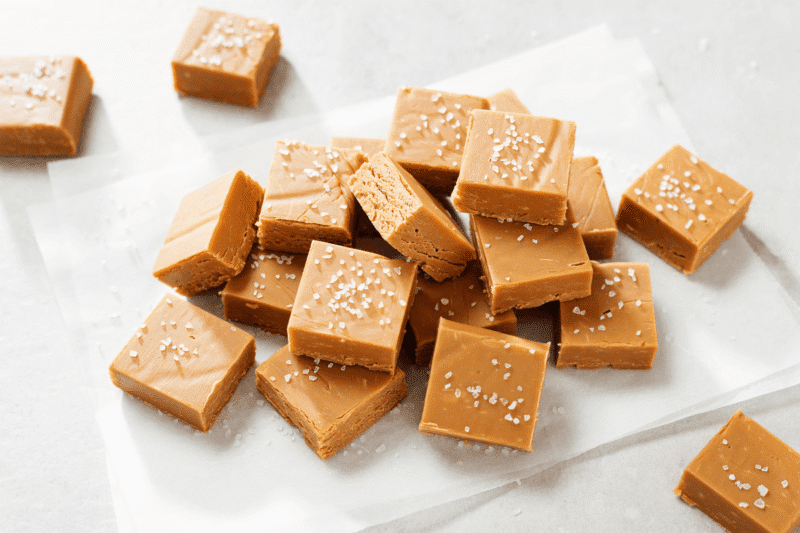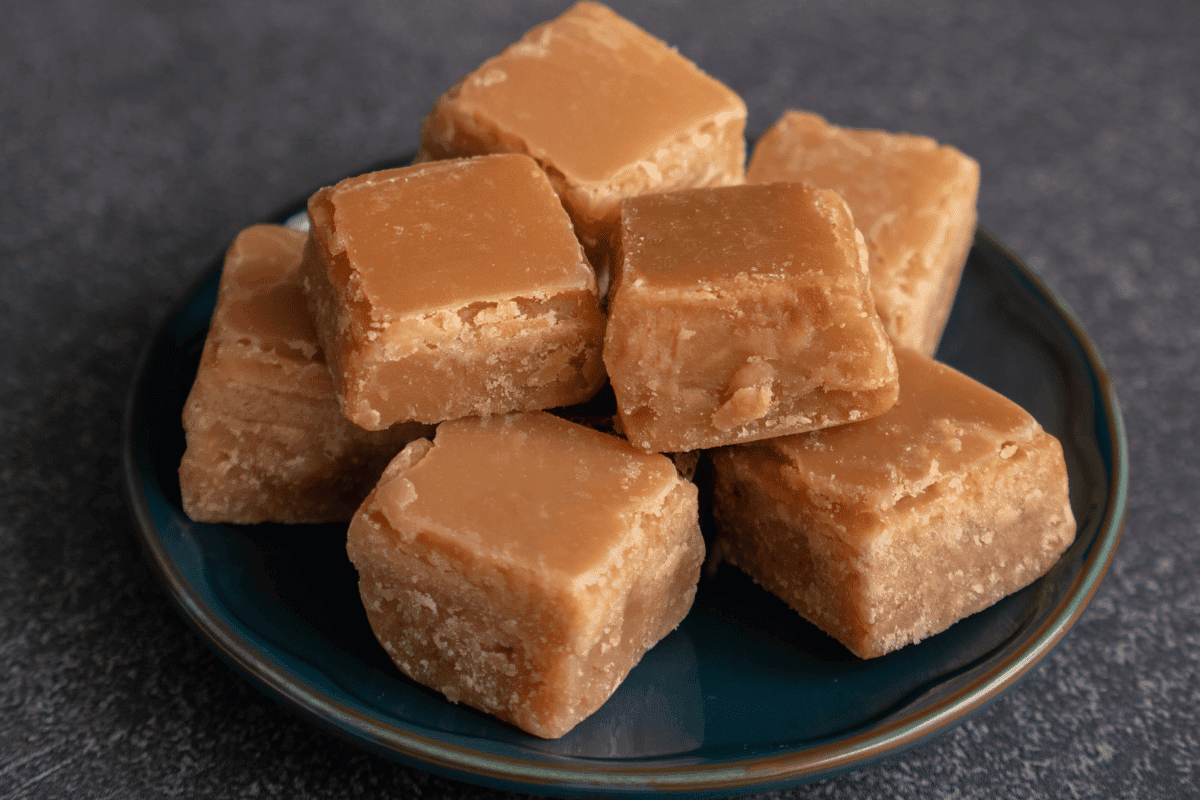Introduction
Whether you’re looking to recreate a taste of Cornwall at home, impress guests with a homemade gift, or simply satisfy your sweet tooth with something truly special, this Cornish clotted cream fudge recipe delivers exceptional results every time.
Table of Contents
Using authentic Trewithen clotted cream, this foolproof clotted cream fudge recipe creates silky, melt-in-your-mouth fudge that captures the essence of Cornwall’s rich culinary heritage. With just four simple ingredients and our step-by-step guide, you’ll discover why clotted cream makes all the difference in creating fudge with an unmatched creamy texture and rich, buttery flavour that shop-bought alternatives simply can’t match.
Ready to create your own batch of this Cornish classic? Let’s get started!

How to Make Clotted Cream Fudge
Making clotted cream fudge at home is surprisingly simple when you follow these tried-and-tested few easy steps:
- Heat the base ingredients: In a heavy-based saucepan, gently heat 250g caster sugar, a teaspoon of vanilla essence, and 80g golden syrup over medium heat until the sugar dissolves.
- Reach soft ball stage: Bring the mixture to a rolling boil and cook until it reaches 115°C (240°F) on a sugar thermometer – this is the crucial soft ball stage.
- Remove from heat: Take the pan off the heat immediately once the correct temperature is reached to prevent overcooking.
- Add the clotted cream: Quickly stir in 200g Trewithen clotted cream until completely incorporated; this creates the signature creamy texture.
- Beat until thick: Using a wooden spoon, beat the mixture vigorously for 5-8 minutes until it becomes thick, glossy, and starts to lose its shine and become more matte.
- Pour and set: Transfer to a baking paper-lined 20cm square tin and smooth the surface with a palette knife.
- Cool completely: Leave at room temperature for 2-3 hours until completely set, then cut into squares and serve.
This method produces approximately 40 pieces of rich, creamy fudge with that distinctive Cornish clotted cream flavour that makes it truly special.
What Makes Trewithen Clotted Cream Fudge Unique?
The Cornwall Advantage
Cornwall’s rolling, green pastures and mild maritime climate create the perfect environment for dairy farming. Our cows graze on mineral-rich grasslands just miles from the coast, producing milk with exceptional flavour and natural sweetness. This unique combination gives Trewithen clotted cream its distinctive taste that simply can’t be replicated elsewhere.
Why Quality Clotted Cream Matters
Not all clotted cream is created equal. Trewithen’s clotted cream contains a minimum of 55% fat content, creating a richer, more luxurious texture in your clotted cream fudge. The higher fat content means your fudge will set properly, have that perfect melt-in-your-mouth consistency, and deliver the deep, buttery flavour that makes Cornish clotted cream fudge so sought after.

Traditional vs Modern Methods
Trewithen still makes clotted cream using the time-honoured Cornish method – gently heating fresh cream in shallow pans until that telltale golden crust forms on top. This slow, careful process takes hours, allowing natural flavours to develop fully.
Modern industrial methods often use thickeners, stabilisers, and rapid heating to create a product that looks similar, but lacks the authentic taste and texture. When you choose traditional clotted cream for your clotted cream fudge recipe, you’re ensuring your homemade treats have that authentic, superior flavour that family and friends will notice immediately.
Clotted Cream Fudge Recipe Ingredients
Creating perfect clotted cream fudge requires just a handful of quality ingredients, each playing a crucial role in achieving that signature texture and flavour. The beauty of this recipe lies in its simplicity; no complicated additives or hard-to-find ingredients, just premium dairy products working together to create something extraordinary.
Essential Ingredients List
- 250g unrefined caster sugar
- A teaspoon of vanilla essence
- 80g golden syrup
- 200g Trewithen Dairy clotted cream
Choosing the Right Clotted Cream
Quality clotted cream is the foundation of exceptional fudge. Trewithen clotted cream’s minimum 55% fat content ensures your fudge will have the perfect texture and won’t separate during cooking.
Equipment You’ll Need:
- Heavy-based saucepan (prevents burning and ensures even heat distribution)
- Sugar thermometer (crucial for reaching the correct temperature)
- Wooden spoon
- 20cm square baking tin
- Parchment paper (prevents sticking and makes removal easy)
Helpful Extras:
- Palette knife for smoothing the surface
- Sharp knife for clean cutting
- Airtight containers for storage

Step-by-Step Clotted Cream Fudge Instructions
Preparing Your Workspace
Proper preparation is essential for fudge-making success, as timing becomes critical once you start cooking. Begin by lining your chosen tin with parchment paper, leaving some overhang for easy removal later. Place your sugar thermometer within easy reach and test it in boiling water to ensure accuracy – it should read 100°C (212°F) at sea level.
Gather all ingredients and measure them precisely before you begin, as there’s no time to hunt for items once the mixture is bubbling. Keep your wooden spoon close by and ensure your workspace is clear of distractions. Have a damp cloth ready to wipe the thermometer between uses. Remember, fudge-making moves quickly once you start, so organisation now prevents disasters later!
The Perfect Temperature Guide
Temperature control separates perfect clotted cream fudge from grainy disappointment. Your mixture needs to reach the soft ball stage, precisely 115°C (240°F), where a small amount dropped into cold water forms a soft, pliable ball that holds its shape briefly before flattening.
Watch your thermometer carefully as the mixture approaches this temperature, as it can climb rapidly in the final stages. If you don’t have a thermometer, test by dropping a small amount into a glass of cold water every few minutes once the mixture starts thickening.
Mixing and Setting Techniques
Once you’ve reached the perfect temperature, remove the pan from the heat immediately and work quickly but calmly. Add your clotted cream in one go, stirring constantly to prevent lumps from forming. The mixture may bubble vigorously – this is normal and shows the cream is incorporating properly.
Now comes the crucial beating stage: use your wooden spoon to beat the mixture vigorously for 3-5 minutes until it transforms from glossy to matte and starts to thicken noticeably. You’ll feel the resistance increase as the fudge develops its characteristic texture. Stop beating as soon as the mixture loses its shine and begins to hold its shape; over-beating can cause the fudge to seize and become crumbly.
Pour immediately into your prepared tin, working quickly as the mixture will continue to thicken. Use a palette knife to smooth the surface, then resist the temptation to disturb it. Allow to cool completely at room temperature for at least 2-3 hours before cutting, patience here ensures clean, professional-looking squares.
Expert Tips for Perfect Clotted Cream Fudge
Common Mistakes to Avoid
- The most frequent error is rushing the temperature – many home cooks remove the mixture from heat too early, resulting in fudge that never sets properly.
- Overheating beyond 115°C creates grainy, hard fudge that’s impossible to salvage.
- Always use a heavy-based pan, as thin pans create hot spots that can burn the sugar and ruin the entire batch.
- Avoid the temptation to scrape the sides of the pan while cooking, as any sugar crystals on the sides can seed the entire mixture and create grainy fudge.
How to Test for Soft Ball Stage
The soft ball test is your most reliable method for perfect fudge, even with a thermometer. Drop a small amount of the hot mixture into a glass of very cold water using a clean teaspoon. The mixture should immediately form a soft ball that holds together when you lift it out but flattens when pressed gently between your fingers.
If the mixture dissolves completely in the water, it’s not ready – continue cooking. If it forms a hard ball that doesn’t flatten easily, you’ve overcooked it. The perfect soft ball stage creates a pliable mass that you can roll briefly between your fingers before it loses its shape.

Variations and Flavour Ideas
Now you’ve perfected this clotted cream fudge recipe, you can start to get creative and add your own flavour preferences to create delicious fudge to suit your taste.
Cornish Sea Salt Clotted Cream Fudge
Elevate your clotted cream fudge with a pinch of authentic Cornish sea salt, which enhances the natural sweetness while adding sophisticated depth. Add half a teaspoon of flaked sea salt during the beating stage, or sprinkle coarse crystals on top before the fudge sets for dramatic presentation
Vanilla Bean Clotted Cream Fudge
Transform your fudge into an aromatic masterpiece by scraping the seeds from one vanilla pod directly into the cream mixture before heating. The tiny black specks create visual appeal while delivering intense vanilla flavour that complements the clotted cream beautifully.
Seasonal Flavour Combinations
- Autumn Spice: Add a teaspoon of mixed spice (cinnamon, nutmeg, cloves) and a handful of toasted chopped hazelnuts for a warming seasonal treat perfect for autumn.
- Lemon Zest: Incorporate the finely grated zest of two lemons for a bright, citrusy twist that cuts through the richness, ideal for spring celebrations or to enhance your lemon cream tea.
- Lavender Honey: Stir in a tablespoon of local honey and a pinch of dried culinary lavender for a floral fudge that celebrates summer in Cornwall.
Storing and Serving Your Clotted Cream Fudge
Properly stored clotted cream fudge maintains its quality for up to two weeks at room temperature, though it’s best enjoyed within the first week for optimal texture and flavour.
Best Storage Methods
Store your clotted cream fudge in an airtight container lined with parchment paper to prevent sticking and maintain freshness. Layer pieces between sheets of parchment if stacking, and keep the container in a cool, dry place away from direct sunlight and heat sources. Avoid refrigerating unless absolutely necessary, as this can cause the fudge to become overly firm and lose some of its creamy texture.
Gift Packaging Ideas
Homemade clotted cream fudge makes an exceptional gift that showcases thoughtfulness and a taste of Cornish tradition. Cut into uniform squares and arrange in small cellophane bags tied with ribbon for individual treats, or present larger portions in decorative tins lined with tissue paper. For a truly professional presentation, wrap each piece individually in wax paper or parchment, then arrange in a beautiful box to give to family and friends.
There’s something truly magical about creating homemade clotted cream fudge that connects you to generations of Cornish confectionery tradition. With this recipe and our expert guidance, you now have everything needed to craft luxurious fudge that rivals any artisan sweet shop – all from the comfort of your own kitchen. Leave a comment below if you enjoyed making this clotted cream fudge recipe. We hope you enjoyed it!
Making Clotted Cream Fudge – Your FAQs Answered
How to make fudge with clotted cream?
Making fudge with clotted cream follows the same basic principles as traditional fudge, but with one crucial difference – the clotted cream is added after reaching the soft ball stage rather than during the initial heating. Start by heating sugar and golden syrup to 115°C (240°F), then remove from the heat and immediately stir in the clotted cream. Beat vigorously until the mixture thickens and loses its shine, then pour into a lined tin to set.
What can I make with leftover clotted cream?
Leftover clotted cream is a treasure that shouldn’t go to waste! Beyond fudge, you can create decadent clotted cream ice cream, fold it into homemade shortbread for extra richness, or use it as a luxurious filling for Victoria sponge cake. It makes an exceptional base for creamy pasta sauces, adds indulgence to scrambled eggs, or can be swirled into coffee for a Cornish twist on café au lait.
Can you mix clotted cream with chocolate?
Absolutely! Clotted cream and chocolate are a match made in heaven. For chocolate clotted cream fudge, add 100g of good-quality dark chocolate (chopped) during the beating stage after incorporating the clotted cream.
Is clotted cream fudge crumbly?
Properly made clotted cream fudge should never be crumbly – quite the opposite! The high fat content in quality clotted cream creates an exceptionally smooth, creamy texture that’s one of this fudge’s defining characteristics. If your fudge turns out crumbly, it’s usually due to overcooking the sugar mixture, over-beating after adding the clotted cream, or using poor-quality cream with insufficient fat content.
Can you freeze clotted cream fudge?
Yes, you can freeze clotted cream fudge for up to three months, though the texture may change slightly upon thawing. Wrap individual pieces in parchment paper, then place in an airtight container or freezer bag to prevent freezer burn. When ready to enjoy, thaw slowly in the refrigerator overnight, then bring to room temperature before serving.
What temperature should clotted cream fudge reach?
Clotted cream fudge must reach exactly 115°C (240°F) for proper setting. This temperature is crucial because it’s hot enough to create the right sugar concentration for fudge consistency, but not so hot that it becomes hard and grainy.
Why won’t my clotted cream fudge set?
If your fudge won’t set, the most common cause is not reaching the proper temperature during cooking. The mixture must hit 115°C (240°F) to achieve the right sugar concentration. Other causes include using cream with too low a fat content, adding the clotted cream when the mixture was too cool, or not beating long enough after adding the clotted cream. Unfortunately, undercooked fudge cannot be saved by reheating, as this will cause the clotted cream to separate. Prevention is key- always use a thermometer and quality clotted cream with high fat content.
How do you cut fudge cleanly?
For professional-looking squares, use a large, sharp knife warmed under hot running water and dried between cuts. Mark your cutting lines lightly with the knife tip first, then cut in one smooth motion without sawing back and forth.
Can I make clotted cream fudge without a thermometer?
While a thermometer gives the most reliable results, you can make successful fudge using the cold water test. Drop a small amount of the boiling mixture into very cold water—it should form a soft ball that holds together when lifted but flattens when pressed gently. Test every few minutes once the mixture starts thickening, as the progression from liquid to soft ball happens quickly. This method requires practice and attention, but many traditional fudge makers relied on it for generations before thermometers became common kitchen tools.
